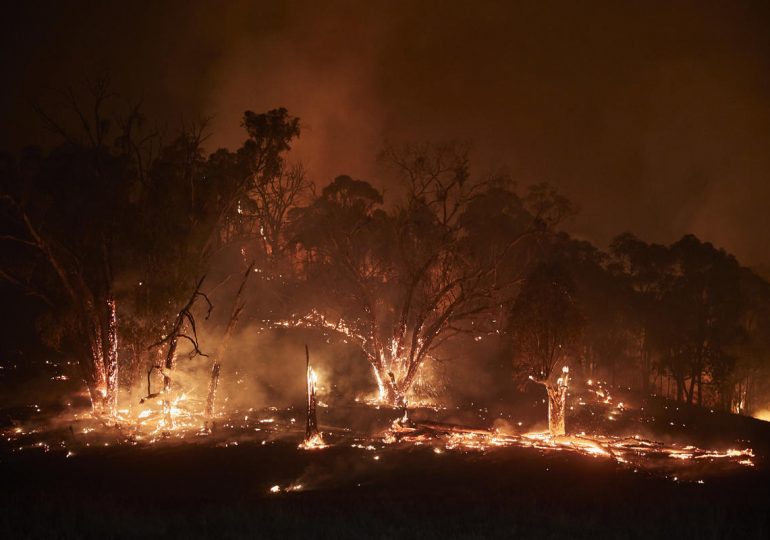Any day now, the Australian Government will publish the first comprehensive projections of how climate change will impact communities and ecosystems across Australia. The release coincides with a critical decision on our climate and energy future – the setting of a new target for cutting climate pollution. Here we take stock of what the new National Climate Risk Assessment means for our 2035 climate target.
The release of the delayed National Climate Risk Assessment cannot come soon enough. Australians are already facing the harsh reality of life on a fast heating planet—from extreme heat and longer fire seasons to devastating floods and destructive storms. Without data on future climate risks, how are we to best prepare for what is coming?
The Risk Assessment is also a vital input to the Government’s decision on Australia’s 2035 climate target. It will lay out the stark consequences of failing to reduce climate pollution and phase out fossil fuels fast enough. Consequences that are measured not only in hits to our bank accounts but in loss of lives, of precious species and ecosystems, and of everything we love and depend upon. People who are privy to the Risk Assessment have described it as “frankly terrifying” and “extremely confronting”.
There is, however, a flip side to this story. One not only of loss but of our agency in this current moment. Let me explain.
The future we choose
The Risk Assessment is expected to show the risks and impacts we’ll face under different levels of warming—1.5°C, 2°C and 3°C. In other words, it will offer us a map of different possible futures, and of the consequences for people and the planet that will flow from today’s decisions. It will show us what we are losing but, most importantly, just how much we can and must fight to save.
We don’t yet know exactly what it will say but we can make some informed guesses, as the Risk Assessment will be based on data from the latest generation of global climate models, which also informed the latest Assessment Report from the Intergovernmental Panel on Climate Change (IPCC).
Perhaps the most confronting part will be the damages that are already baked in. Even under a scenario that sees warming limited as far as possible, we must be prepared for a significant escalation from the impacts we are seeing today. Why? Because it takes time for the climate system to fully respond to the increase in greenhouse gas concentrations brought on by the burning of fossil fuels. Meaning we will still be wearing the consequences of the fossil fuel industry for some time. Even if we were to somehow reach zero emissions tomorrow, the Earth would continue to warm.
Bushfire in Snowy Mountains, Australia.
Fire seasons in Australia area longer and more dangerous due to climate change. Keeping Australian communities safe requires deep and rapid cuts to climate pollution this decade.
© Kiran Ridley / Greenpeace
However, by around 2040, or around the time a child born today is in high school, we start to see significant differences in the kind of future that will result from today’s climate targets. In other words, in the kind of future that is still available to us if we take the strongest possible action now and through this coming decade, versus the avoidable pain and suffering that would be brought on by weak climate targets.
Turning down the heat
Remember—many benefits of a stronger target, such as new jobs and economic opportunities, could be realized almost immediately. Clean energy also offers the path to more affordable and reliable electricity for Australians.
In terms of the physical impacts of climate change, the differences will also be felt sooner than many people realise.
We expect the Risk Assessment will provide projections for many different kinds of climate hazards, including extreme temperatures, fire weather, and extreme rainfall and flooding. As well as how these different hazards may interact and compound one another, and their impact on our economy, health and security.
For some of these hazards, notably the number of extremely hot days, the difference between a 1.5°C scenario and a higher warming scenario becomes clear very quickly.
Through rapid and sustained reductions in global climate pollution, we would start to bend the global temperature curve by 2040, and in doing so immediately start to limit the number of deadly heatwaves that would otherwise occur.
Extreme heat is the greatest climate danger facing Australians, particularly the young, elderly, economically disadvantaged, or otherwise more vulnerable in our community. It is responsible for more premature deaths than all other weather-related disasters combined. Mental health also suffers, with extreme heat linked to increased rates of self harm and aggression. It can cripple our infrastructure, reduce crop yields, and pummel vulnerable ecosystems.
So let’s be clear. Every effort we make now to reduce climate pollution and phase out fossil fuels will mean fewer hospitalisations and death due to extreme heat exposure, reduced strains on our mental wellbeing, fewer disruptions to daily life, and a lifeline to native species that may otherwise struggle to adapt.
The further we look ahead, the greater the positive impact
Beyond 2040, the consequences of today’s decisions become bigger still. We begin to see effects on the frequency and severity of other types of extreme weather events, including extreme rainfall and flooding.
When it comes to sea level rise, while we cannot stop the seas from rising due to the amount of excess heat now stored in the ocean and the inertia in the melting of polar ice, strong action today can still limit the rate and extent of sea level rise. For some communities, this may be the difference between a future to which it is possible—albeit with great effort—to adapt, and one that overwhelms them.
For some of our most important and diverse ecosystems, such as tropical coral reefs, the difference between strong and weak targets is quite literally the difference between giving them a fighting chance and watching them mostly disappear.
Aerial view of the Great Barrier reef off the Whitsunday Islands.
For tropical coral reefs, the difference between strong and weak climate targets is the difference between giving them a fighting chance and watching them disappear.
© Michael Amendolia / Greenpeace
All in all, by the end of this century—well within the lifespan of many people alive today—our decisions today will have had a profound impact on the lives, livelihoods, wellbeing, and security of our communities. As a father to a young child, I think about this reality every day.
Why our 2035 target matters
Whether or not the new Risk Assessment will be published before the Government makes a decision on its 2035 target remains to be seen. But Australians have a right to know what it says and to be part of deciding our future. We cannot leave it to closed door discussions, and hope that what emerges is good enough.
Here is what we know for certain.
First, the same science that predicted with such devastating prescience the consequences we would be feeling today from failing to cut climate pollution, is telling us the future is still in our hands. That every decision matters. And the decision on a 2035 target may be the most consequential of all.
Second, that Australia, and all countries, have a legal obligation to do everything possible to limit warming to 1.5°C. The latest science is unequivocal—we are seconds to midnight, edging towards perilous tipping points that threaten to unleash irreparable damage and widespread suffering. This is not a time to be timid, or even to limit our aspirations to what currently feels achievable. In the words of the Paris Agreement, our 2035 target must reflect our “highest possible ambition”.
Third, that every fraction of a degree of avoided warming matters. And while there is so much we are losing to climate change, and will continue to lose, there is even more that we can still save.
Wind turbines near Port Augusta, South Australia. The National Climate Risk Assessment will lay out the stark consequences of failing to reduce climate pollution and phase out fossil fuels fast enough.
© Ella Colley / Greenpeace
This is a moment for bold, decisive and far-sighted leadership. For setting the strongest possible target—one informed by care for current and future generations and a love of the natural world that sustains us, not by the vested interests of the fossil fuel industry. Anything less is like taking a match to our future. Let’s not stuff this up.
Leave a comment





